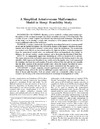Identificador persistente para citar o vincular este elemento:
https://accedacris.ulpgc.es/jspui/handle/10553/76479
| Título: | A simplified arteriovenous malformation model in sheep: Feasibility study | Autores/as: | Qian, Z Climent, S Maynar Moliner, Manuel Uson-Garallo, J Lima-Rodrigues, MA Calles, C Robertson, H Castaneda-Zuniga, WR |
Clasificación UNESCO: | 32 Ciencias médicas 320111 Radiología |
Palabras clave: | Natural-History Brain Swine |
Fecha de publicación: | 1999 | Publicación seriada: | American Journal of Neuroradiology | Conferencia: | Annual Meeting of the American-Society-of-Neuroradiology | Resumen: | BACKGROUND AND PURPOSE: Recently, a swine model of a cerebral arteriovenous malformation (AVM) has been developed that closely resembles a human AVM of the brain. The creation of such a model requires sophisticated neurointerventional techniques. The purpose of this study was to develop a simple and cost-effective AVM animal model that does not require additional endovascular techniques.METHODS: A surgical anastomosis was created in seven sheep between the common carotid artery and the ipsilateral jugular vein, followed by ligation of the jugular vein above the anastomosis and of the proximal common carotid artery below the anastomosis. The anastomosis was created on the left side in four animals and on the right side in three. Cerebral angiography from the contralateral carotid artery was performed before and immediately after surgery to delineate the relevant cerebral vascular anatomy and to determine the direction of blood flow.RESULTS: An angiographic appearance simulating an AVM was found in all the animals. The ramus anastomoticus and arteria anastomotica functioned as the feeding vessels to the rete mirabile, which represented the nidus in our model, and to the jugular vein, which represented the draining vein from the malformation. Extensive collateral flow through the rete mirabile into the distal segment of the external carotid artery above the Ligature was observed angiographically, with retrograde flow through the surgical anastomosis into the jugular vein.CONCLUSION: A simple surgically created experimental model for cerebral AVMs was developed in sheep without the need for additional complex endovascular catheter manipulations of intracranial branches. Such an animal model can substantially reduce the cost of research and training in the neurointerventional or radiosurgical management of AVMs. | URI: | https://accedacris.ulpgc.es/handle/10553/76479 | ISSN: | 0195-6108 | Fuente: | American Journal Of Neuroradiology [ISSN 0195-6108],v. 20 (5), p. 765-770, (Mayo 1999) |
| Colección: | Artículos |
Citas de WEB OF SCIENCETM
Citations
24
actualizado el 25-feb-2024
Visitas
75
actualizado el 28-dic-2024
Descargas
35
actualizado el 28-dic-2024
Google ScholarTM
Verifica
Comparte
Exporta metadatos
Los elementos en ULPGC accedaCRIS están protegidos por derechos de autor con todos los derechos reservados, a menos que se indique lo contrario.
